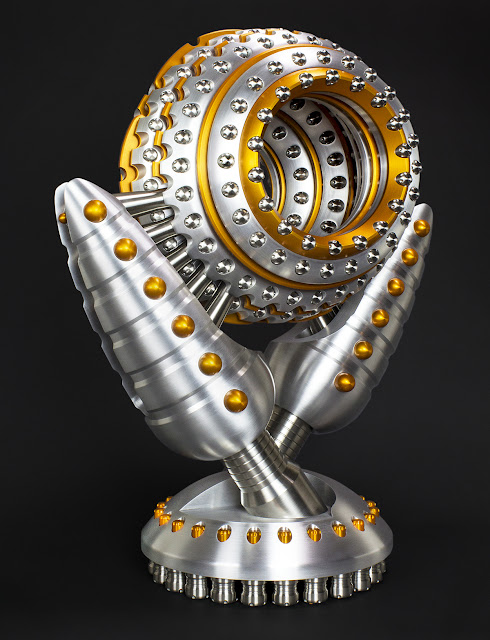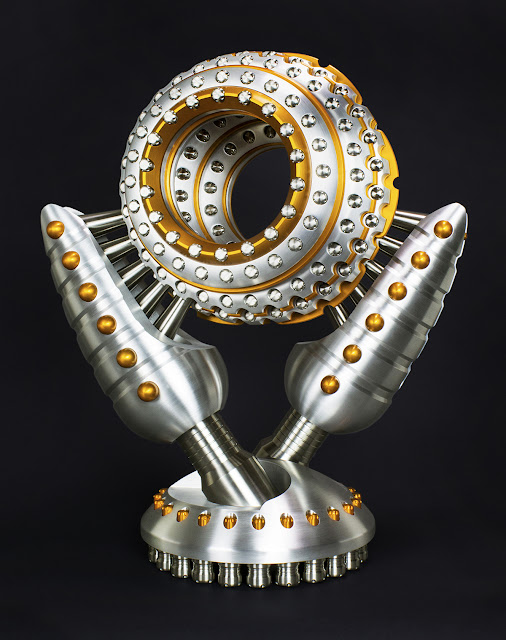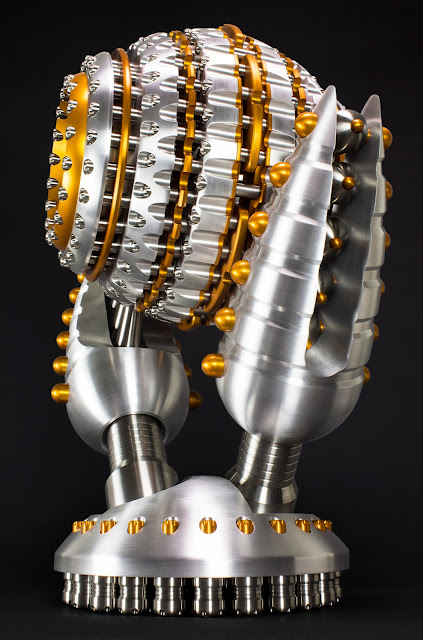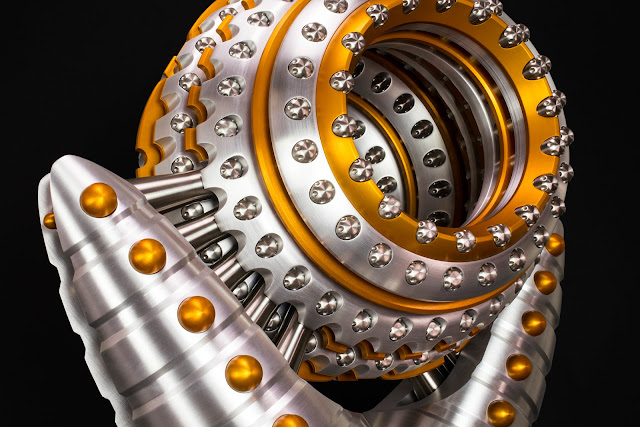Last year, I spent the fall making a small army of pocket sized sculptures. They were very popular and a blast to make, but they were relatively simple as far as designs go. So as winter set in, I felt that I was ready to turn my attention to something bigger and more technically complex. Now it is spring and I have emerged from my studio hibernation with something I think is really special.
For the last 14 weeks I have been undertaking one of my most ambitious works to date. Not ambitious in terms of size (although it is a largish piece), but more of a personal record in terms of the substantial number of parts I was required to make to execute this idea. It is a design with well over a thousand individually machined parts. If you count spare parts (I always make extras), almost 1100.
While still a healthy size as far a machined metal sculptures go, it is by far the largest parts count I have ever attempted. I had to make hundreds upon hundreds of custom bolts, pins, and spacers in addition to the dozens of other more intricate parts that make up the assembly.
(Sculpture is 20.5" tall, 17" wide, and 11" deep. It weighs 88 pounds)
This work is also unique in that it has a rather complex interior space, something that I find difficult to work into many of my designs.
The opening into the interior is approximately 5" at its smallest, so you can easily stick your whole arm through the center of this piece.
As far as my design motivations for this work?...Well lately...rather than thinking about these sculptures in terms of representing one big idea or one specific meaning, I am finding it more useful and accurate to say that these works speak to a collection of smaller ideas, some overlapping, and even conflicting at times.
I bet many artist feel pressure to impose meaning in places were maybe there is none, and are reluctant to reveal other meanings in service to creating a tidy narrative around their works. There is a belief that a concise narrative makes the work more accessible to others, but this is not always true with my type of work. I find a fixed narrative or interpretation betrays the complexity of the creative process, and can even be alienating if it does not fit with a persons own perceptions of the work.
So I have started to say that I collect lots of small concepts, bits of technical information, personal meanings, and compositional elements as I work. Then I take these simpler elements and smash them together and recombine them until something more complex and refined emerges.
I think comparing disparate pieces of information is how most new ideas are created, it is certainly the case with this work, I could speak to over a dozen loosely connected points of interest that went into this composition. But as you already know, I am only willing to share a few of them.
One example of an influence that I am willing to share, comes in part from planning my most recent exhibition at the Baltimore Museum of Industry.
(see link and show details here)
The BMI was originally an old cannery that now houses an array of machines, products, and tools from across Baltimore's industrial past.
I paid many visits to the BMI over the last 18 months while planning my exhibition there. I took a lot of extra time during those visits to appreciate the BMI's collection to see how I might make some connections to my own work.
(see link and show details here)
The BMI was originally an old cannery that now houses an array of machines, products, and tools from across Baltimore's industrial past.
I paid many visits to the BMI over the last 18 months while planning my exhibition there. I took a lot of extra time during those visits to appreciate the BMI's collection to see how I might make some connections to my own work.
My time amongst the various industrial artifacts got me thinking about how artists have always appropriated antiquated industrial processes and given them a new lease on life within the arts (glass blowing, type setting, wood turning are all examples). Likewise, artists have also been some of the first to adopt new technologies to see what novel uses they may have (photography and video). I realized that this contrast between the old and the new is something that machine work, my sculptural process, encapsulates beautifully.
There are processes that I use in my shop that have not changed for hundreds of years, there are also processes in my shop that represent the cutting edge of digital fabrication technologies. I think committing to exploring both ends of this spectrum has led me to some of my most interesting work.
Walking around the BMI, I intentionally pulled a number of references from their collection for this particular piece, far more than I would ever admit to for any other design. I wanted some part of this sculpture to embody my experience there.
As I said, there are many other influences present in this work, as the beginning sketches of this design go back almost 2 years.
Ok ok, one more. Look up "John Ernst Worrell Keely", really interesting story in its own right. Was he a con man? inventor? or was he the first machinist sculptor?..
I'll just leave that one hanging out there.
I'll just leave that one hanging out there.
The Drawing for this work is just as ambitious as the sculpture, but a bit too big for a blog image.
It is actually too big for the printer as well, 60x60 inches is as big as my printing company can accommodate, but even this is not properly to scale.
Sadly, it is very compressed above which compromises it a great deal.
But rest assured, each part is faithfully included in there somewhere. I took a bit more liberty with the use of a bold color (singular) and composition on this one.
I can't wait to get this monster printed and on a wall somewhere, as it is like an engineers version of a mandala.
The exploded diagram and assembly breakdown is unfortunately another drawing that just doesn't scale well for the screen.
The exploded assembly is just an organized mess until you spend some time wrapping your head around it.
Additional process notes: Even after all the parts were completed, It took two entire days to assemble everything. Threading and torquing down each of the hundreds of bolts with custom made wrenches while taking great care not to scratch or ding the finish was quite the meditative exercise. I have never held my breath so much in my entire life.
This project saw me spending many weeks with repetitive operations, so I made it a point to enjoy taking the time to refine and discover efficiencies for each step and part-program as the days went on.
There is a lot to be learned from making 440 small spacers, even when you are on part 423, something new might still occur to you.
I also had to expand my Anodizing lab to accommodate some of the larger diameter ring shaped parts. They simply would not fit in my existing tanks, but I knew they had to be orange, so I ended up refurbishing much of my anodizing line and installing new tanks just for the few parts in this work.
I will be sure to put them to good use again in the future.
I will be sure to put them to good use again in the future.
Many people have commented that I do a bad job of illustrating the scale of my works in these posts.
To remedy this, here is the hand spinner collaboration I did sitting atop a 1.5"diameter steel rod for scale reference.
the stainless bolt heads on the work are each half an inch in diameter, and the large orange bolt caps on the legs are three quarters.
the stainless bolt heads on the work are each half an inch in diameter, and the large orange bolt caps on the legs are three quarters.
(there are also a couple good desk shots in the montage below)
Lots of other great process images for inspiration as well.
So in conclusion, this is what 14 weeks of my life looks like...I hope you like the result.
The pendulum will likely be swinging back to some small works for a little while, I have some things I want to try and some other collaboration announcements coming, so stay tuned.
Also, in case you missed it, the newest version of my art book is now up for sale on the website and on Blurb, links below.
as always, comments and questions are welcome.
















